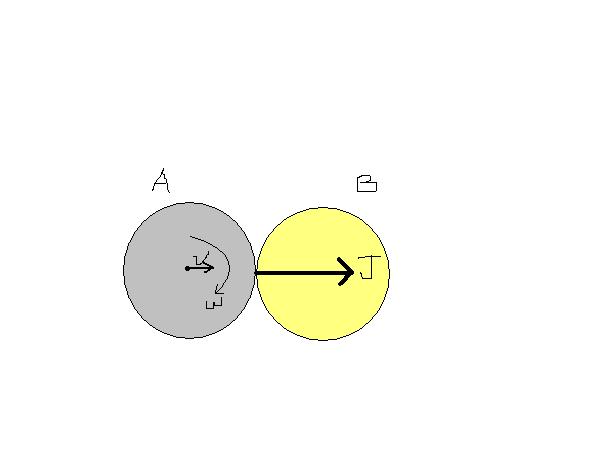the collision is elastic...and the plane is smooth..ball A will give its translational vel. V but not his angular velcity W..so ball B will be moving with vel V n No angular velocity(slipping actually)..and to maintain the momentum and K.E the ball a keeps rotatinf fixind in a place(slipping again)...
so.. ball a comes rotating n translating....gives his translational vel to ball B and starts rotating without being displaced...
so Wa=W, Wb = 0, Va = 0, Vb = V hence Wa>Wb and Vb>Va
A smooth sphere A of radius R and mass M, collides elastically and head on with an identical sphere B at rest. The entire system is on a smooth horizontal ground. Given that the sphere A was rolling without slipping with an angular velocity W and vel. of centre of mass as V at the time of collision. After collision their angular speed are WA and WB and their velocities of their centre of mass are VA and VB then
which of the following are correct?
1. WB = W
2. WA = W
3. WA < WB
4. WA = WB
5. VA = V
6. VB = V
7. VA=VB
8. VA < VB
9. VA = 0
10. VB = 0
do give your reasons for your answers!!!
-
UP 0 DOWN 0 0 5

5 Answers
sorry to add my doubts in ur thread but m using tiit frm mob. So m unable to create a new thread 1.in an inertial frame L=I*angular velocity is true and dL/dt=TORque is false..why? 2.the angular velocity of engine(and hence of wheel) of scooter is proportional to petrol input per second.the scooter is moving on a frictionless road with uniform velocity.if petrol input is increased by 10%,the linear velocity of scooter is increased by___ .
the collision is elastic...and the plane is smooth..ball A will give its translational vel. V but not his angular velcity W..so ball B will be moving with vel V n No angular velocity(slipping actually)..and to maintain the momentum and K.E the ball a keeps rotatinf fixind in a place(slipping again)...
so.. ball a comes rotating n translating....gives his translational vel to ball B and starts rotating without being displaced...
so Wa=W, Wb = 0, Va = 0, Vb = V hence Wa>Wb and Vb>Va
exactly what subhodip says..
when ball A strikes ball B, it imparts an impulse 'J' on B that passes through its COM...
since the collision is elastic and masses are same, J = mv, which gives a translational velocity 'v' and ball A comes to rest...
so ball A continues its rotation at a fixed position and the other moves forward with velocity 'v'
so
vA=0, vB=v, ωA=ω, ωB=0
But the cases would have been different if the surface was rough and if the balls were not smooth(where frictional impulse would come into existence)